West Hartford Bicycle Facility Plan Meeting Sparks Questions and Concerns for Residents

Audio By Carbonatix

On Webster Hill Boulevard, bike lanes are included on the recently paved portion, but won't be added to the rest of the road until it's time for repaving. Photo credit: Ronni Newton
Thursday evening’s Bicycle Facilities Plan information meeting, regarding the town’s drafted Bicycle Facilities Plan, provided residents an opportunity to learn more about the project’s purpose, plan, and development and also gave community members the floor for questions and concerns.
By Bridget Bronsdon
Bike facilities have been a hot topic of conversation for the riding community as many West Hartford residents are concerned about the draft plan the town published in late May. The Bicycle Plan and Facility Selection and Design Guide provided a close look at the types of facilities, selection process, and implementation plan that would go into updating the town’s roadways for bicycle safety and accessibility.
The intent is not to add bicycle facilities on their own, however, but rather to create a plan for implementation in conjunction with other roadway projects.
During a public information meeting Thursday, held at the Bishops Corner Senior Center, Francisco Gomes, the town’s planning consultant from FHI Studio, provided a breakdown of the project’s purpose, context, and the development process.
The drafted plan, which is meant to update the existing 2016 Bicycle Facilities Plan, as directed by the town’s Complete Streets Policy, provides the town with “a guide for planning and designing facilities that are safe, appropriate, and comfortable for a wide range of users.”
The plan’s vision? “To provide a seamless network of on and off-street bicycle routes linking destinations such as schools, parks, shopping, and public transportation from one end of West Hartford to the other in an accessible and comfortable manner for people of all ages and abilities.”
However, as part of West Hartford’s Vision Zero Action Plan, an update to the the 2016 Bicycle Facility Plan and development of the Bicycle Facility Design Guide was also recommended.
The early stages of development for the plan began with a survey.
An online survey was conducted in February and March of 2024 to better understand the needs, thoughts, and concerns of residents regarding roadways used for bicycling.
The survey revealed that just under half of participants considered the development of more bike lanes and facilities along the streets in town a “high priority.” The survey also found that riders refrain from biking West Hartford’s streets mostly due to the amount of traffic, the speed of traffic, aggressive or distracted drivers, and the lack of bicycle lanes or other facilities.
Following the survey, state and federal guidance documents were reviewed to ensure consistency with standards and the best practices were implemented. Since then, the bicycle plan and facilities map have been updated.
The next steps will be the review and endorsement of the plan by the Pedestrian and Bicycle Commission and then the adoption of the plan by the Town Council.
The roughly 20 residents in attendance,Thursday, however, still had remaining questions and concerns, with one of the biggest being the timeline of the process. “It still feels a little abstract,” an attendee said.
Gomes and Town Engineer Greg Sommer explained that while the long-term vision is to construct a network, there is no established timeline or schedule for the facilities to be built as they are dependent on several factors.
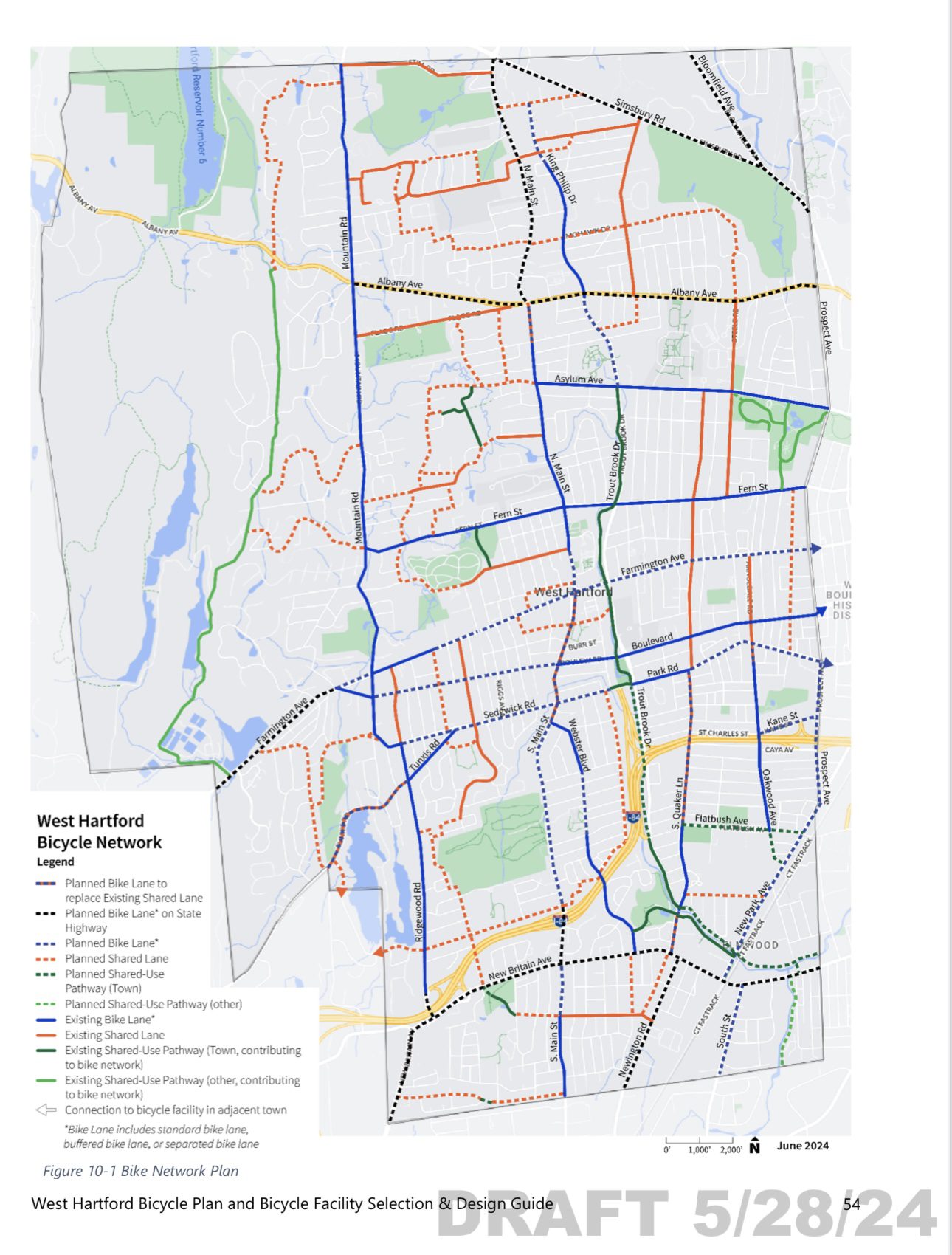
Screenshot of the bicycle network from the town of West Hartford Bicycle Plan and Facility Selection and Design Guide 2024.
“As we look to build out our bicycle network, we’re looking for opportunities to do so, typically those coincide with resurfacing projects, construction, when markings need to be refreshed,” Sommer said. “Those are opportunities when we can revisit a roadway and make changes or modifications for the bike facilities,” he said.
Gomes also noted that the vision must be addressed on a year-by-year, budget-by-budget, grant-by-grant, and construction project basis.
“It could be 50 years before we have a network that looks like what we have on the map. This is a long-term vision,” said Gomes. However the intention is continual and steady progress, he said.
Since the facility implementation aims to coincide with existing town projects, residents asked if there will be any connection to the ongoing West Hartford Center Infrastructure Master Plan, the design for which is still under discussion. Sommers said that since there are so many competing interests and needs, they are first aiming to get diverse input from business owners, bikers, and other members of the public to determine what will be the most well-received before moving ahead with designs.
Residents also wondered if there are any plans to connect the Trout Brook Trail to The Center. “How much emphasis is being placed on specifically connecting that gem [the Trout Brook Trail] of a shared path to these business centers in town, The Center being included among them,” an attendee asked.
“That’s definitely something we’re looking at but I don’t know a timeline of when we’re going to get there,” said Sommer.
Another major concern voiced by residents was the lack of reference to the town’s Vision Zero Action Plan, an initiative aimed at eliminating severe injuries and deaths by 2033. Attendees expressed frustration that the Vision Zero Action Plan and high injury network priorities were missing in the town’s draft Bike Facilities Plan.
“With respect to the high injury network, it factored into all the decision-making that went into this plan,” said Gomes. “The Vision Zero Plan recommended that we do exactly this so this is a manifestation of the Vision Zero Plan,” he said.
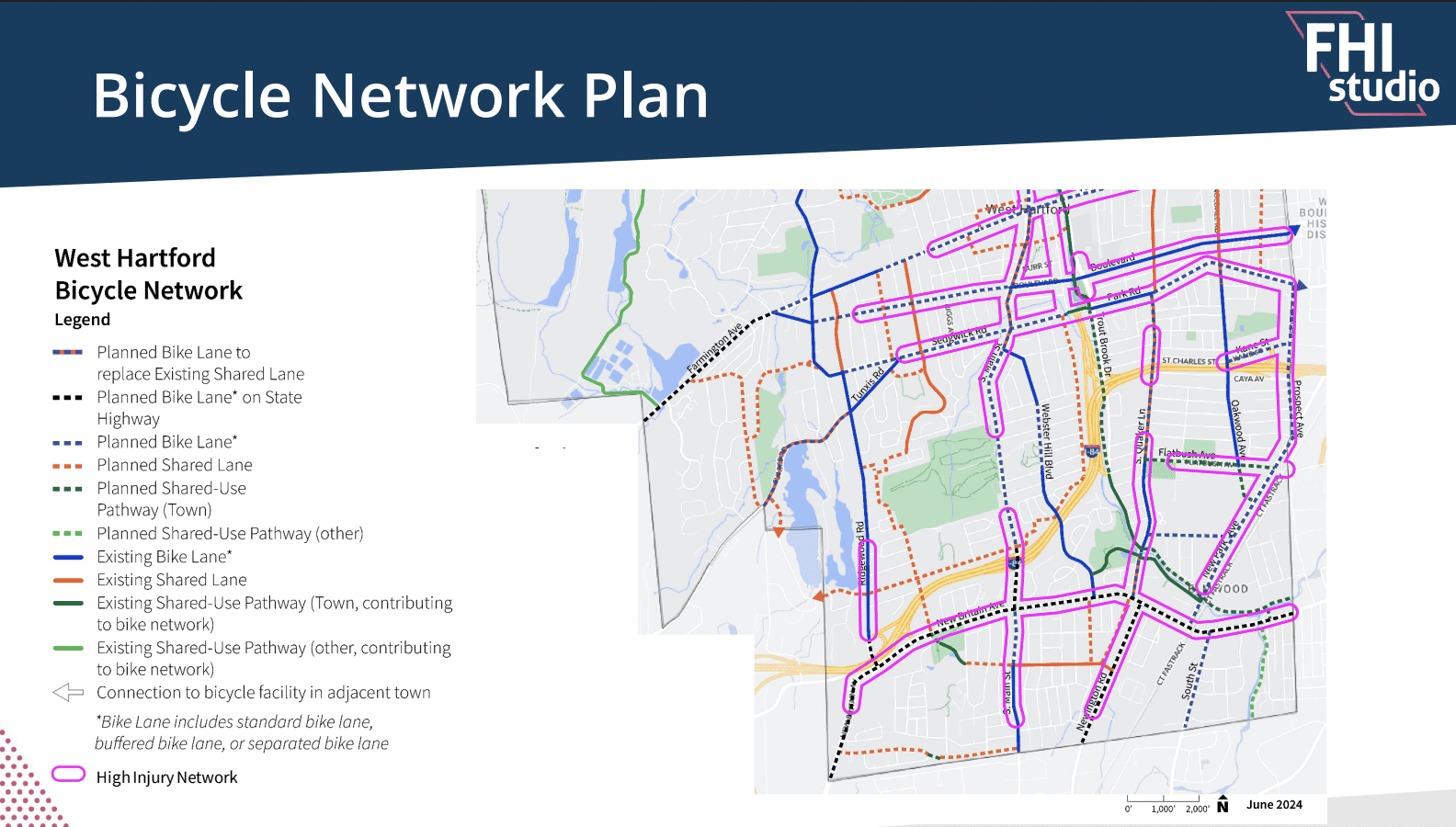
While some attendees were still discouraged, Gomes also said that they will work to include language to acknowledge the high injury network in the plan.
Other frustrations included traffic speed and biker safety. Many attendees expressed concern that the recommended facilities are inappropriate as many drivers go much faster than the speed limit, specifically on roads such as Boulevard and Ridgewood.
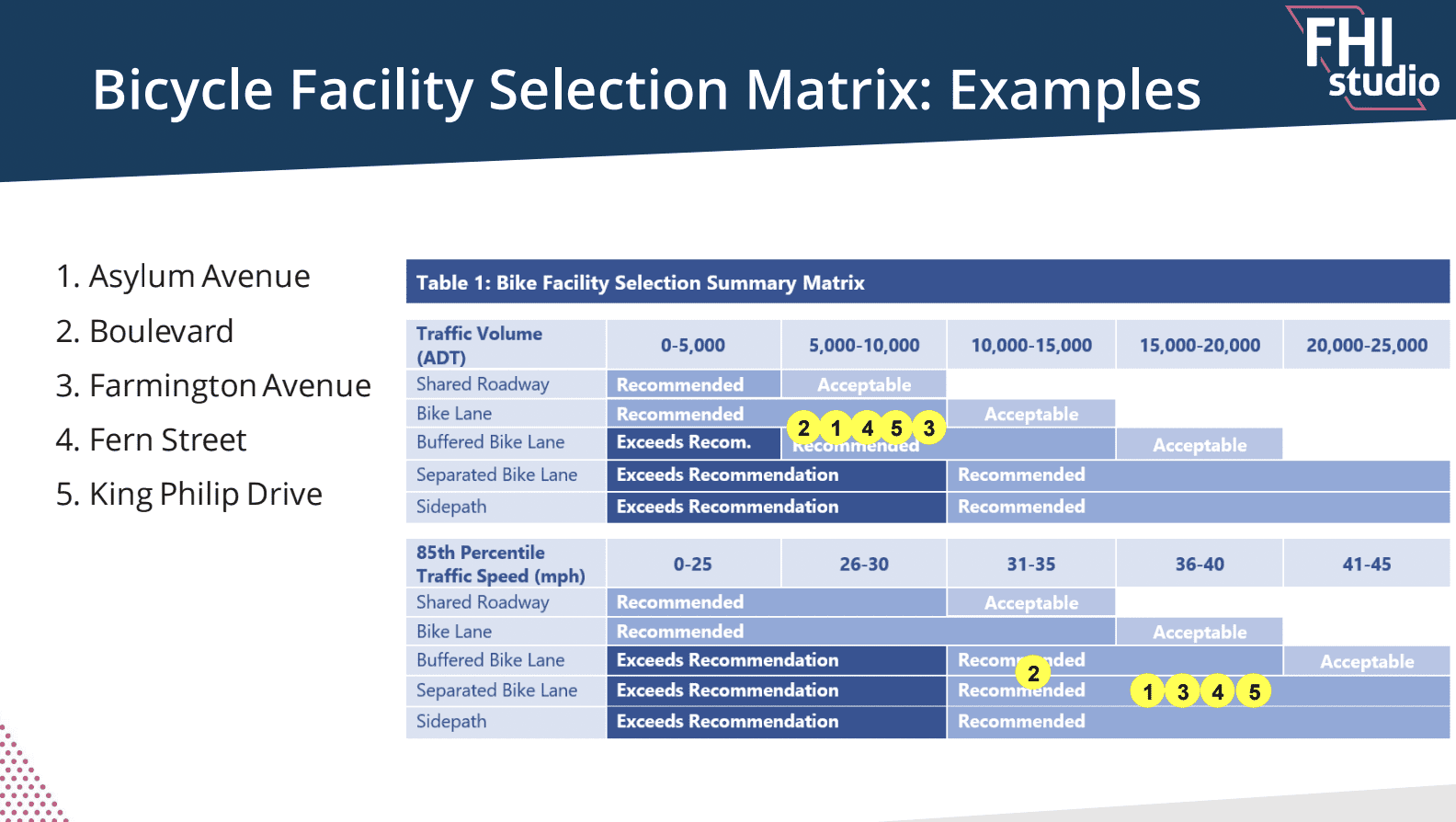
Similarly, traffic volume on Boulevard was also a worry. Several attendees suggested that there should be a focus on traffic calming instead of encouraging bikers and pedestrians to travel through high-traffic areas and dangerous intersections.
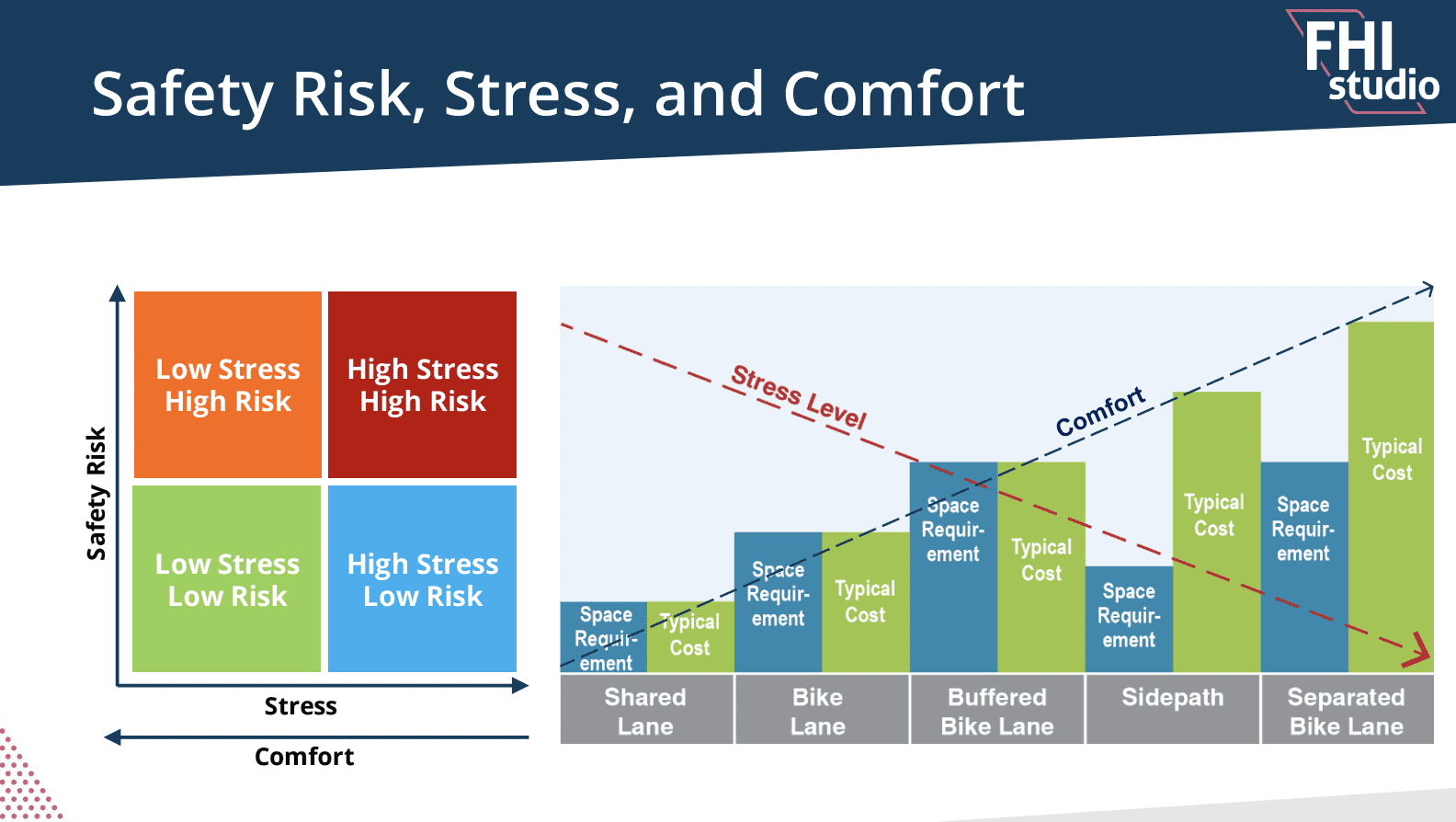
Screenshot of the stress, comfort, and safety risk graphs from Francisco Gomes’ presentation.
Other elements of concern were areas such as schools, parks, and playgrounds where there will be a high volume of children, transparency and communication as the process moves forward, and a false sense of safety bike lanes may provide. Attendees also had worries about existing bike facilities that seem unfit. “What about removal of facilities that were inappropriately marked,” a resident said and referenced the sharrows on South Main Street as an example.
Sommer said that they do not plan on removing any of the existing facilities since facility use is based on rider comfort level.
Like what you see here? Click here to subscribe to We-Ha’s newsletter so you’ll always be in the know about what’s happening in West Hartford! Click the blue button below to become a supporter of We-Ha.com and our efforts to continue producing quality journalism.



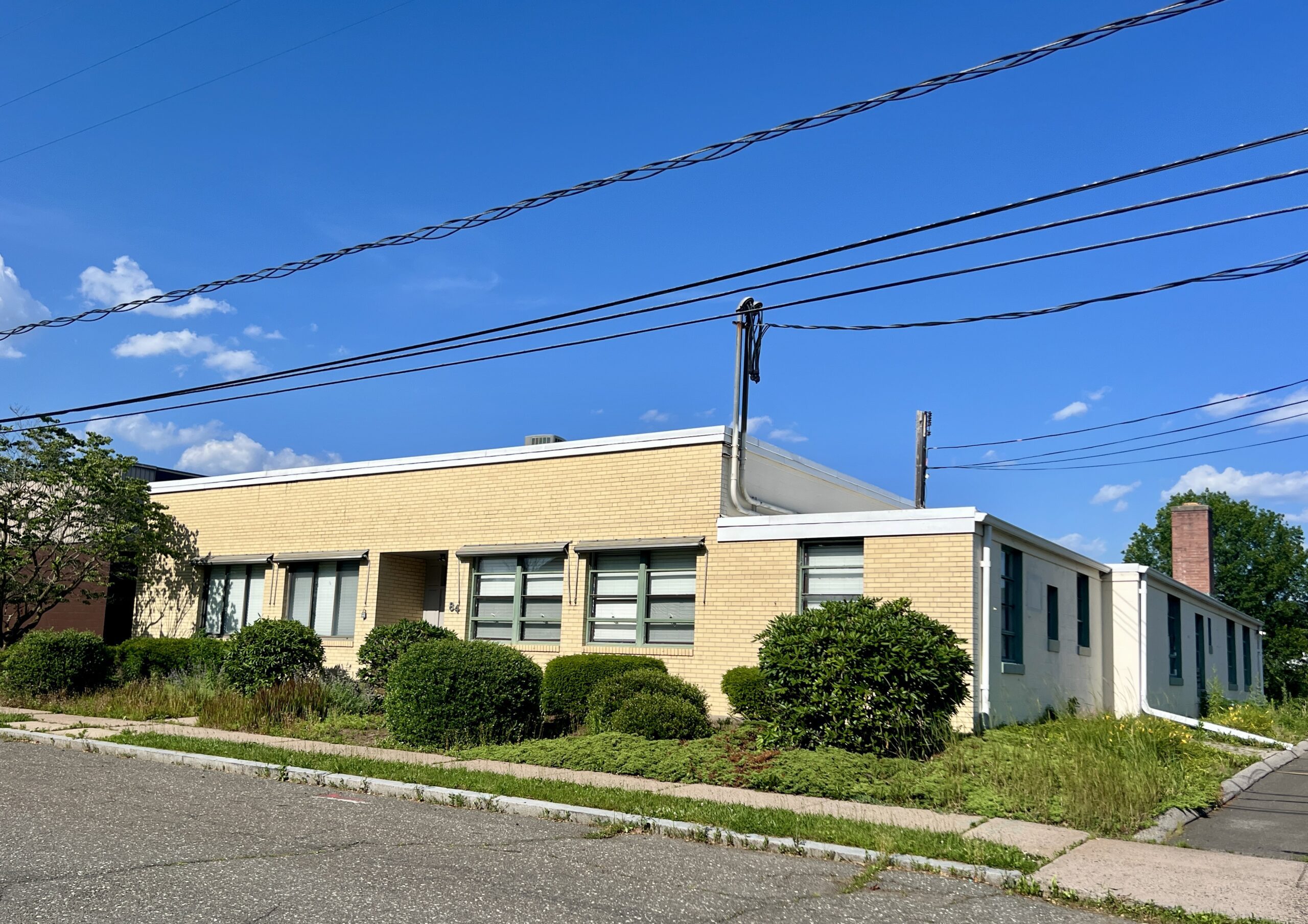
This is not a rant, just trying to offer some observations on the declining state of local cycling in our community.. I’ve lived here in town for 40 years and ridden throughout West Hartford and neighboring communities.
Despite the town’s efforts to improve shared roads and bike paths, riding in town has gotten a LOT more dangerous, especially over the past 10 years. There are plenty of roads and avenues in town I have to avoid simply because they are too densely packed with cars which only gets worse during rush hour. Examples include New Britain Ave, North Main Street in the Bishops Corner area, New Park Ave, Prospect Ave, Mountain Rd, Albany Ave, West Farms Mall area, and parts of Farmington Ave.
Traffic density and speed is very high, drivers are often aggressive, the roads carry landscapers and home contractors towing very wide trailers, delivery vans are everywhere, and drivers are much more distracted by their cellphones and car infotainment systems. All this adds up to a deadly cocktail when you mix bikes and cars together. As we’ve seen, pedestrians are also at a much greater risk from this combination of factors.
Rather than trying to get less cars on the road, the town’s overarching goal seems to be the development of more apartments and commercial buildings, thereby further increasing the number of cars on the road and making the roads even less safe. Gone are the days when you felt safe letting your children ride their bikes to school and around town.
Lesser factors add up to decreased cycling safety too. While some streets have been recently repaved, there are still too many dangerous potholes on our roads. The town should have a publicly accessible database and/or phone app where residents can lookup and report road and sidewalk problems. Lots of communities do this today. Many of the video traffic lights in town do not work properly and do not detect cyclists waiting at a light.
Many drivers are unaware that there’s a 3 Foot passing distance law in Connecticut regarding bicycles. My wife and I have had too many close calls on this. I’ve yet to see a sign posted anywhere informing residents of this law. The town should also have a public education campaign to let residents know about this.
I could go on, but these are the major items that concern me as a cyclist trying to ride safely in West Hartford.